Natural Dyeing – Try These 3 Simple Ways
Dyeing and the use of color are what make fiber arts exciting. Colour can bring interest to any fiber arts project.
Long before textiles were being dyed commercially, people were foraging to source dyes that are found in nature. Now you don’t even need to forage, you can open your pantry to begin natural dyeing.
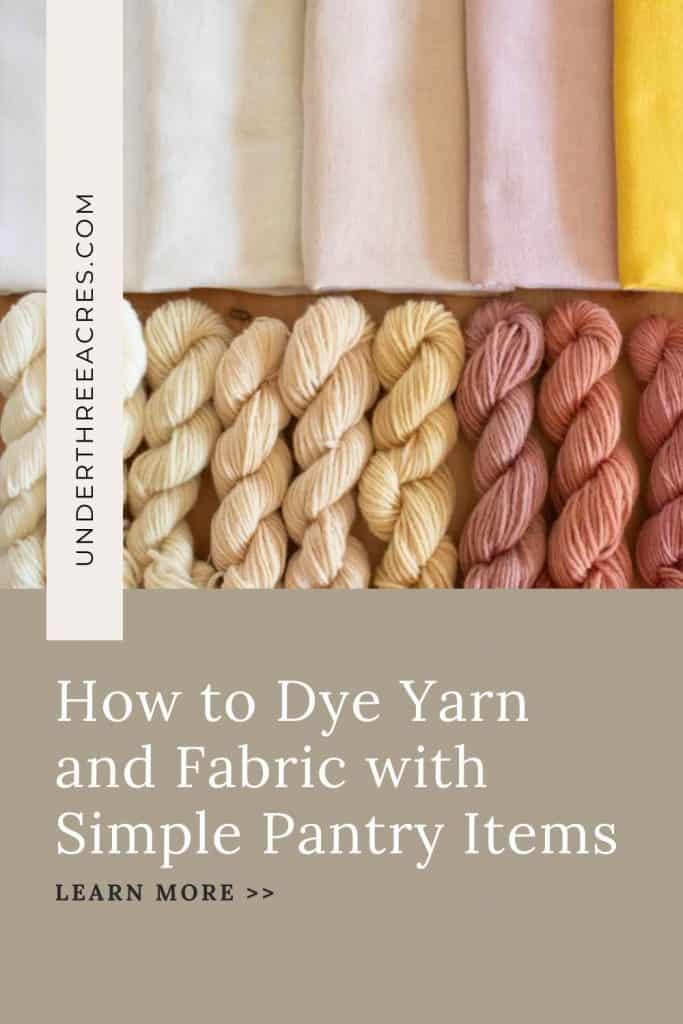
Natural Dyeing for the fun of it…
I recently experimented with different pantry items to create play cloths and yarn for my children’s playtime. Over the years, our Waldorf playthings have been misplaced or played with beyond repair.
I felt the urge to make toys and backdrops for the toy buckets. Flour sack towels and some natural colored yarn were going to be given some new life. The dyed yarn is for a project that the kids and I are working on.
I have been wanting to try natural dyes for a long time. I purchased yarn over a year ago with the intent to dye it. All of the yarns that I used for this project were from the KnitPicks.com bare yarn series.
Now that I have had success with it, I can share with you how easy it is and encourage you to give it a try.
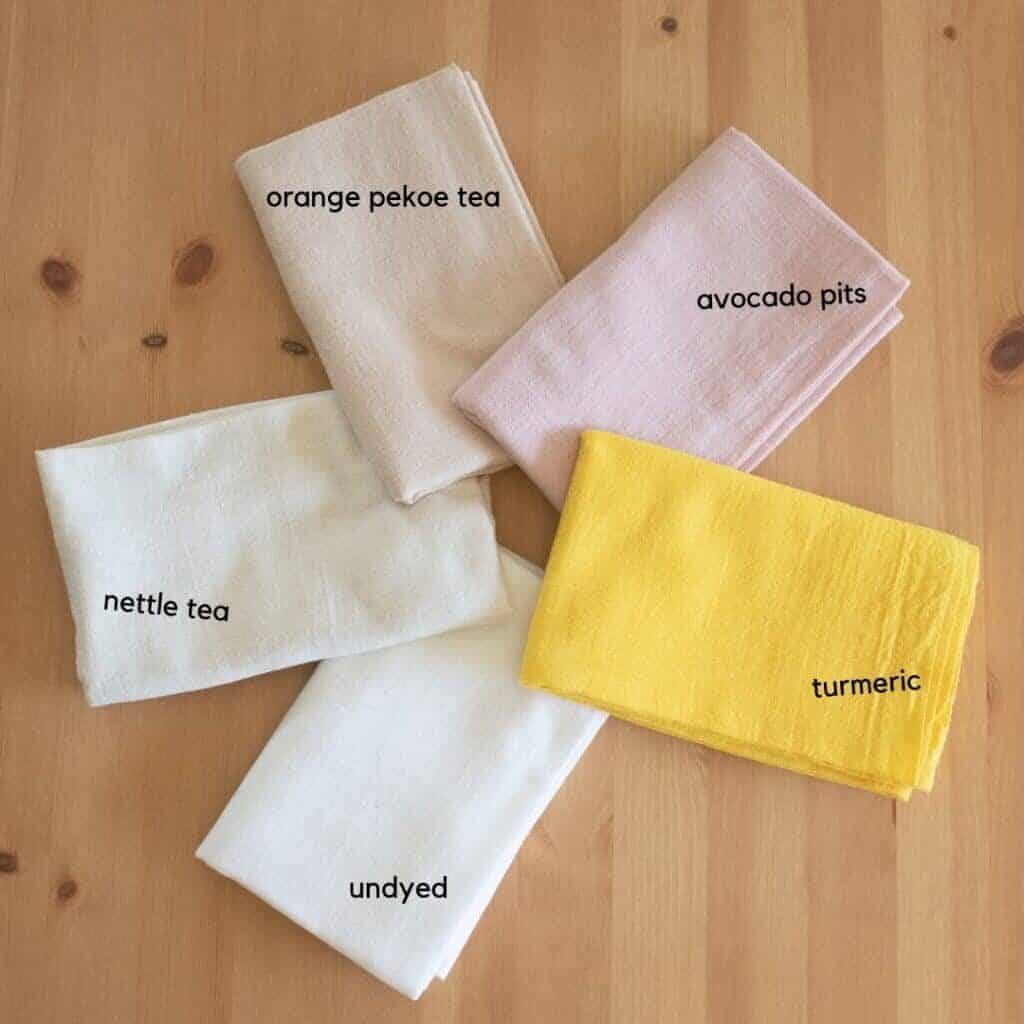
Preparing to Dye Your Fibres
I use a dedicated pot and wooden spoons for all of my dyeing projects. This is advised, especially if you pre-treat your yarn with a mordant like alum. Mordant is used to help increase colorfastness and/or to create a different shade.
Prepare your fabric.
- If your fabric is new, wash it but don’t dry it. If it has already been washed, scour it by hand washing it in water and a drop of dawn dish detergent and rinse it.
Prepare your yarn.
- Soak your yarn in lukewarm water for at least 30-60 minutes. Make sure to fully submerge the yarn. It will absorb the dyes better if it is wet.
- Optional: Pre-mordant your yarn. This is the method I use.
NOTE: Some of my yarn was pre-treated in an alum mordant. The two yellowish skeins were a failed attempt to solar dye with Golden Marguerite flowers. I dyed over the old dye. You can dye over other dyes and yield amazing colors.
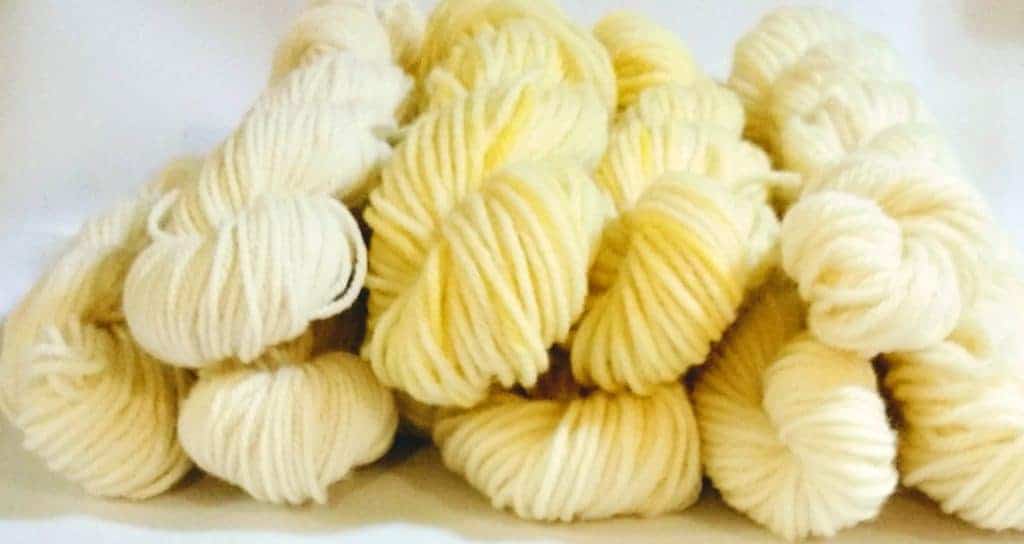
Orange Pekoe Tea
We are big tea drinkers at our house. A couple of us love orange pekoe tea. I normally wouldn’t sacrifice orange pekoe tea for a dye project, but this one happened to be decaffeinated.
We order our groceries online and during a pick-up, we didn’t realize that they had given us decaf. It just doesn’t taste right and I am not one to throw things out. So this huge box of tea sat in the pantry underappreciated until this week.
I used the following method to dye one flour sack towel, about 60g (2oz.) of wool, and one (3-6 month) baby onesie.
To dye fabric or yarn do as follows:
- In a large enamel or stainless steel pot (aluminum pots can change the outcome), bring 3 quarts of water to a boil.
- Add 30 tea bags to the pot and allow it to steep for 30 minutes.
- Remove all of the tea bags and throw them in the compost.
- Add fabric or yarn to the pot. Be sure to use a wooden or plastic spoon to push out the air bubbles. You want it to be as submerged as possible.
- Simmer over medium to low heat for 30 minutes.
- Leave the pot on the stove, but turn off the heat. Let soak for a minimum of 4 hours. I let mine sit overnight. You should push the fabric and yarn underwater every once in a while to keep it submerged.
- Once it has reached the desired color, pour off the tea and rinse the fabric or yarn. Remember that the fibers will lose a few shades when rinsing.
- Fill the sink with enough tepid water to cover your fabric or yarn. Add about a quarter cup of vinegar. Submerge the fabric or yarn and let it soak for 10-15 minutes. This helps to prevent the color from bleeding.
- Rinse until the water is clear.
- Wash by hand with wool wash. Squeeze out as much liquid as possible and hang to air dry.
TIP: Use an old salad spinner to remove the water from the yarn or fabric. It won’t felt the yarn and helps your yarn to dry faster.
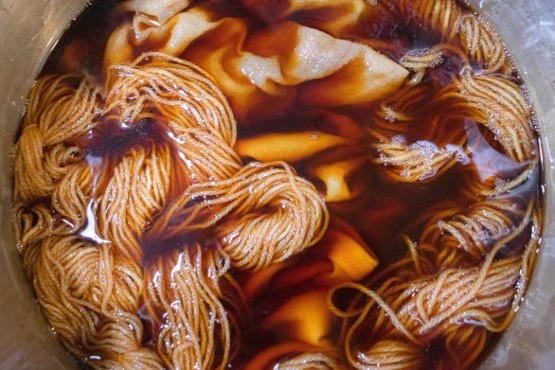
Nettle Tea
I read several blog posts about dyeing with stinging nettles and several about dyeing with tea. We have snow right now, so fresh nettle is a tad difficult to source.
However, I had a box of nettle tea in the pantry that nobody drinks and thought I would try to get green dye from it.
I used the same method that I used with the orange pekoe tea and it barely amounted to anything. If I were to do this again, I would probably double the amount of tea bags that I used.
Avocados
This method requires a little more patience and time. You need to eat avocados and save the pits. It helps if you wash the pits and save them in a freezer bag until you are ready to use them.
I have been wanting to try this for so long and have been making asking my kids to help me with this. Everyone who eats an avocado is supposed to save the pit for mom. Unfortunately, only one of my kids and I actually do this.
I used the following method to dye one flour sack towel and approximately 60g (2oz.) of wool. I could have added more to the dye pot since the color was pretty intense.
To dye fabric or yarn do as follows:
- In a large enamel or stainless steel pot (aluminum can change the outcome), bring 3 quarts of water and 10 avocado pits to a boil.
- Boil for 30 minutes and turn off the heat. Allow the pot to cool overnight.
- In the morning, remove all of the avocado pits and any debris and throw them in the compost.
- Bring the water to a boil. In the meantime, prepare the fabric or yarn as mentioned above.
- Add fabric or yarn to the pot. Be sure to use a wooden or plastic spoon to push out the air bubbles. You want it to be as submerged as possible.
- Simmer over medium to low heat for 30 minutes.
- Leave the pot on the stove, but turn off the heat. Let soak for a minimum of 4 hours. You should push the fabric and yarn underwater every once in a while to keep it submerged.
- Once it has reached the desired color, pour off the tea and rinse the fabric or yarn with hot water. Remember that the fibers will lose a few shades when rinsing.
- Fill the sink with enough tepid water to cover your fabric or yarn. Add about a quarter cup of vinegar. Submerge the fabric or yarn and let it soak for 10-15 minutes. This helps to prevent the color from bleeding.
- Rinse until the water is clear.
- Wash by hand with wool wash. Squeeze out as much liquid as possible and hang to air dry.
TIP: Use an old salad spinner to remove the water from the yarn or fabric. It won’t felt the yarn and helps your yarn to dry faster.
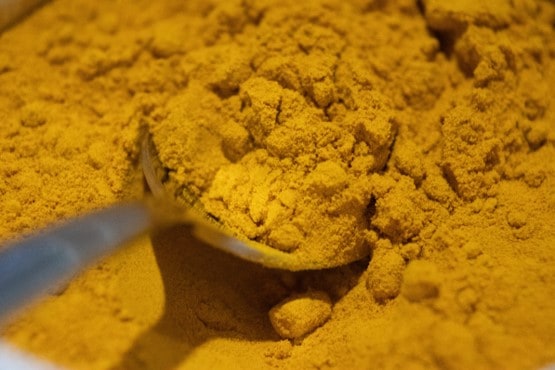
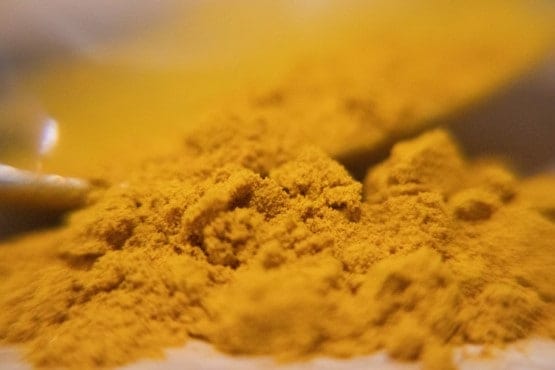
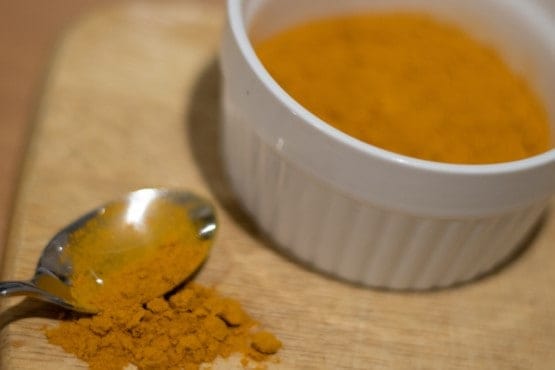
Turmeric
This is the best dye for the first time dyeing. The color turned out to be so intense.
I used the following method to dye one flour sack towel, about 20g (1/2oz.) of wool, and one (3-6 month) baby onesie.
To dye fabric or yarn do as follows:
- In a large enamel or stainless steel pot (aluminium can change the outcome), bring 3 quarts of water to a and 3 tablespoons of turmeric to a boil.
- Prepare the yarn or fabric as mentioned above.
- Add fabric or yarn to the pot. Be sure to use a wooden or plastic spoon to push out the air bubbles. You want it to be as submerged as possible.
- Simmer over medium to low heat for 30 minutes.
- Leave the pot on the stove, but turn off the heat. Let soak for half an hour or longer. You should push the fabric and yarn underwater every once in a while to keep it submerged.
- Once it has reached the desired colour, pour off the tea and rinse the fabric or yarn. Remember that the fibres will lose a bit of colour when rinsing.
- Fill the sink with enough tepid water to cover your fabric or yarn. Add about a quarter cup of vinegar. Submerge the fabric or yarn and let it soak for 10-15 minutes. This helps to prevent the colour from bleeding.
- Rinse until the water is clear.
- Wash by hand with wool wash. Squeeze out as much liquid as possible and hang to air dry.
TIP: Use an old salad spinner to remove the water from the yarn or fabric. It won’t felt the yarn and helps your yarn to dry faster.
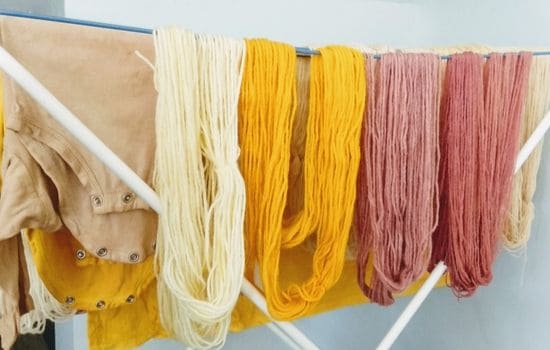
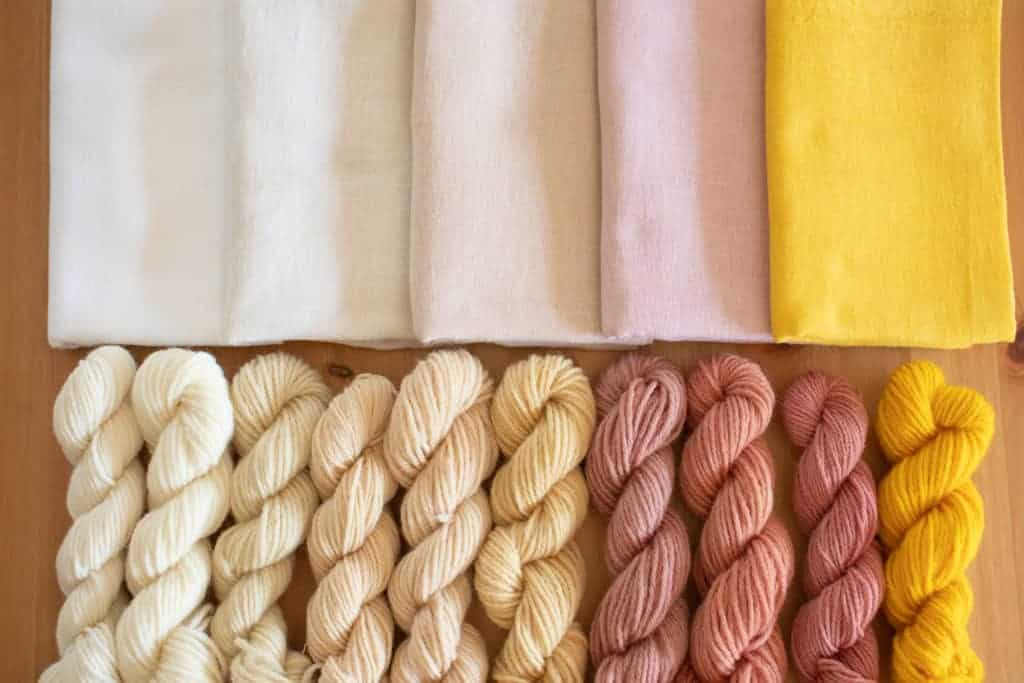
Digging Deeper
Once you and your children experience dyeing your own textiles, you may want to dive in deeper. There are a great number of books that explore dyeing with natural materials.
You might also want to consider growing your own dyer’s garden. This is a fun project for the whole family. Some plants to consider are black nebula carrots, calendula, marigolds, coreopsis, blackberries, beets, red cabbage, and onions.
Depending on where you live, you can also forage for dye plants such as tansy, goldenrod, pokeberry, and lichens. Lichens produce lovely colors.
My favorite Dyer’s handbook is Wild Color. It is well illustrated and explains how to achieve different shades from the same plant.
Recommendations
Every time that I feel the urge to dye, I head straight to the library and pick up the following books. There are several others that I have looked at, but these are the ones that I grab first.
I have yet to try dyeing play silks for the children. In the past, I have dyed cheap white sheets and yardage from Ikea. It isn’t as nice as the play silks, but it is a frugal alternative. The kids love the sheets for building forts.
You can use any wool or animal-based fibers with these recipes. I may have had more success if I had used soy milk to prepare the cotton flour sack towels. The book Botanical Colour at your Fingertips is all about dyeing plant-based textiles like cotton, linen, and flax.
I get all of my bare yarns from KnitPicks. The price point is excellent and the quality is great. If you are interested in using the same yarn, I used Bare Hare and Wool of the Andes Worsted.
I would be interested to hear from you if you’ve ever tried natural dyeing. Tag me on Instagram @underthreeacres or send me photos by email.
If you enjoyed this post, be sure to check out similar posts like Making Felt Balls or my Free Peg Doll Crochet Pattern.







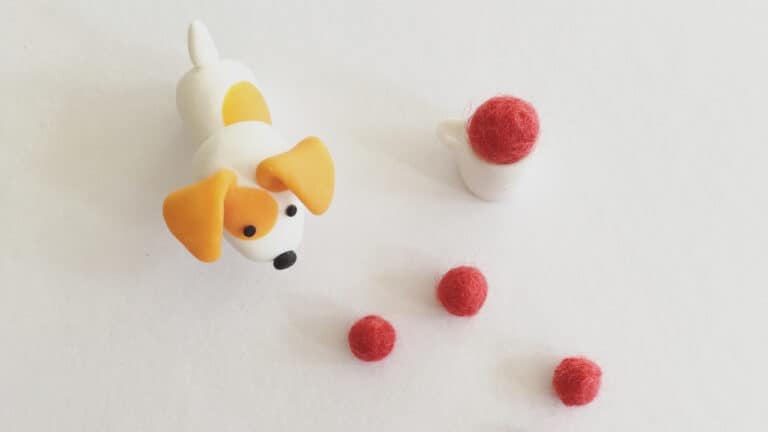

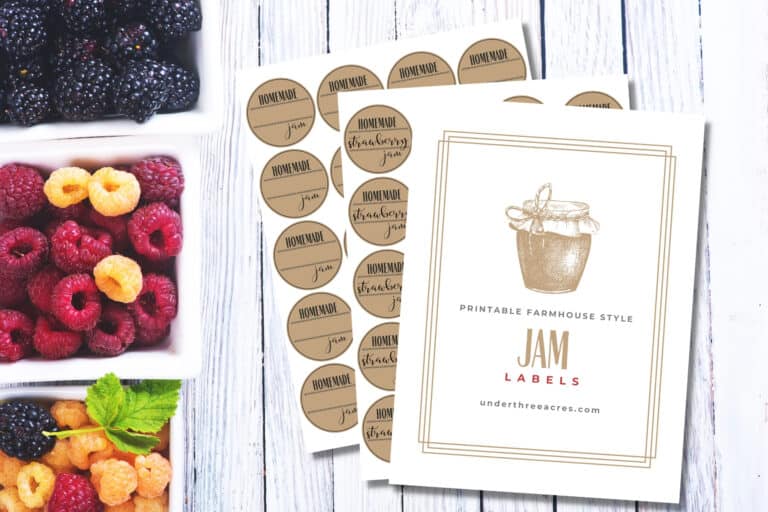


2 Comments